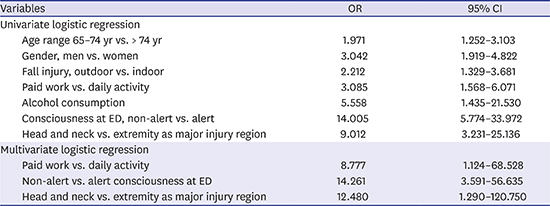1. Murray CJ, Vos T, Lozano R, Naghavi M, Flaxman AD, Michaud C, et al. Disability-adjusted life years (DALYs) for 291 diseases and injuries in 21 regions, 1990-2010: a systematic analysis for the Global Burden of Disease Study 2010. Lancet. 2012; 380(9859):2197–2223.
2. Choi JH, Kim SH, Kim SP, Jung KY, Ryu JY, Choi SC, et al. Characteristics of intentional fall injuries in the ED. Am J Emerg Med. 2014; 32(6):529–534.

3. Spaniolas K, Cheng JD, Gestring ML, Sangosanya A, Stassen NA, Bankey PE. Ground level falls are associated with significant mortality in elderly patients. J Trauma. 2010; 69(4):821–825.

4. Caterino JM, Valasek T, Werman HA. Identification of an age cutoff for increased mortality in patients with elderly trauma. Am J Emerg Med. 2010; 28(2):151–158.

5. Bergeron E, Clement J, Lavoie A, Ratte S, Bamvita JM, Aumont F, et al. A simple fall in the elderly: not so simple. J Trauma. 2006; 60(2):268–273.

6. Alamgir H, Muazzam S, Nasrullah M. Unintentional falls mortality among elderly in the United States: time for action. Injury. 2012; 43(12):2065–2071.

7. Labib N, Nouh T, Winocour S, Deckelbaum D, Banici L, Fata P, et al. Severely injured geriatric population: morbidity, mortality, and risk factors. J Trauma. 2011; 71(6):1908–1914.

8. Con J, Friese RS, Long DM, Zangbar B, O'Keeffe T, Joseph B, et al. Falls from ladders: age matters more than height. J Surg Res. 2014; 191(2):262–267.

9. Gelbard R, Inaba K, Okoye OT, Morrell M, Saadi Z, Lam L, et al. Falls in the elderly: a modern look at an old problem. Am J Surg. 2014; 208(2):249–253.

10. Rau CS, Lin TS, Wu SC, Yang JC, Hsu SY, Cho TY, et al. Geriatric hospitalizations in fall-related injuries. Scand J Trauma Resusc Emerg Med. 2014; 22(1):63.

11. Kim J, Shin SD, Im TH, Lee KJ, Ko SB, Park JO, et al. Development and validation of the excess mortality ratio-adjusted injury severity score using the international classification of diseases 10th edition. Acad Emerg Med. 2009; 16(5):454–464.

12. Son HM, Kim SH, Shin SD, Ryoo HW, Ryu HH, Lee JH. Occupational fall injuries presenting to the emergency department. Emerg Med Australas. 2014; 26(2):188–193.

13. Kim SH. Risk factors for severe injury following indoor and outdoor falls in geriatric patients. Arch Gerontol Geriatr. 2016; 62:75–82.

14. Taira T, Morita S, Umebachi R, Miura N, Icimura A, Inoue S, et al. Risk factors for ground-level falls differ by sex. Am J Emerg Med. 2015; 33(5):640–644.

15. Tripathy NK, Jagnoor J, Patro BK, Dhillon MS, Kumar R. Epidemiology of falls among older adults: a cross sectional study from Chandigarh, India. Injury. 2015; 46(9):1801–1805.

16. Rasche P, Mertens A, Bröhl C, Theis S, Seinsch T, Wille M, et al. The “Aachen fall prevention App” - a smartphone application app for the self-assessment of elderly patients at risk for ground level falls. Patient Saf Surg. 2017; 11(1):14.

17. Sahyouni R, Mahmoodi A, Mahmoodi A, Huang M, Tran DK, Chen JW. Interactive eBooks in educating patients and their families about head injury regardless of age. Clin Neurol Neurosurg. 2017; 156:41–47.

18. Helling TS, Watkins M, Evans LL, Nelson PW, Shook JW, Van Way CW. Low falls: an underappreciated mechanism of injury. J Trauma. 1999; 46(3):453–456.
19. Hartholt KA, Polinder S, Van der Cammen TJ, Panneman MJ, Van der Velde N, Van Lieshout EM, et al. Costs of falls in an ageing population: a nationwide study from the Netherlands (2007–2009). Injury. 2012; 43(7):1199–1203.

20. Mathers LJ, Weiss HB. Incidence and characteristics of fall-related emergency department visits. Acad Emerg Med. 1998; 5(11):1064–1070.

21. Nakada TA, Nakao S, Mizushima Y, Matsuoka T. Association between male sex and increased mortality after falls. Acad Emerg Med. 2015; 22(6):708–713.

22. Janssen DJ, Burns BJ. Experience of pre-hospital treatment of survivors of falls-related trauma by an Australian helicopter emergency medical service. Injury. 2013; 44(5):624–628.

23. Kent A, Pearce A. Review of morbidity and mortality associated with falls from heights among patients presenting to a major trauma centre. Emerg Med Australas. 2006; 18(1):23–30.

24. Kelsey JL, Procter-Gray E, Hannan MT, Li W. Heterogeneity of falls among older adults: implications for public health prevention. Am J Public Health. 2012; 102(11):2149–2156.

25. Stevens JA, Rudd RA. Circumstances and contributing causes of fall deaths among persons aged 65 and older: United States, 2010. J Am Geriatr Soc. 2014; 62(3):470–475.

26. Evans D, Pester J, Vera L, Jeanmonod D, Jeanmonod R. Elderly fall patients triaged to the trauma bay: age, injury patterns, and mortality risk. Am J Emerg Med. 2015; 33(11):1635–1638.










 PDF
PDF Citation
Citation Print
Print




 XML Download
XML Download